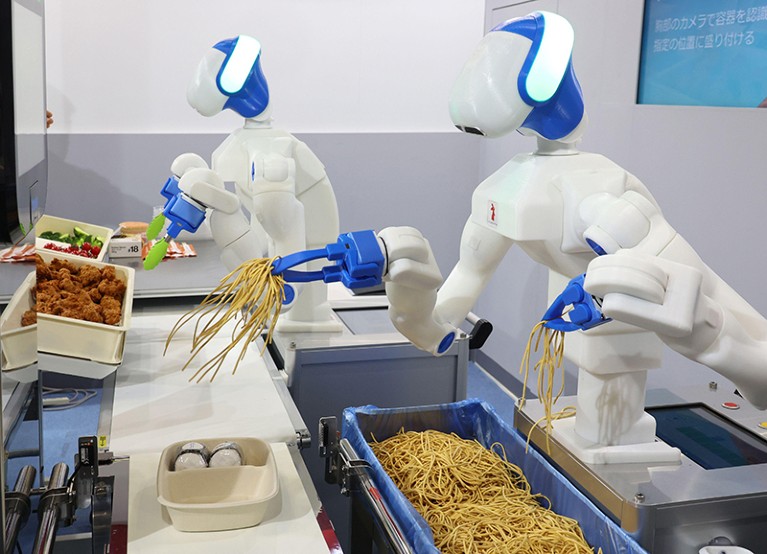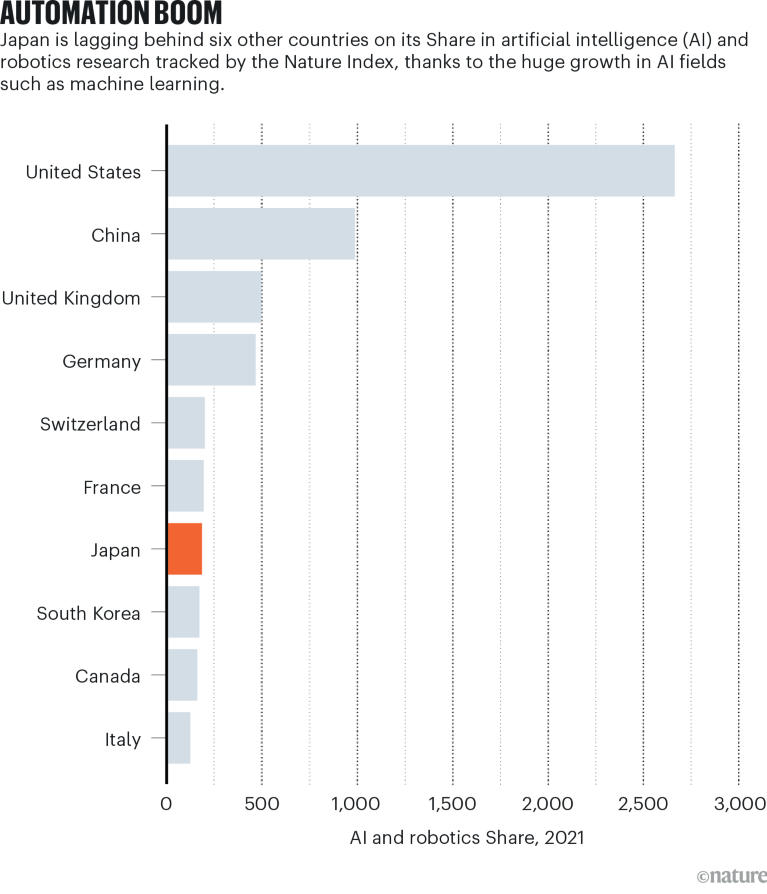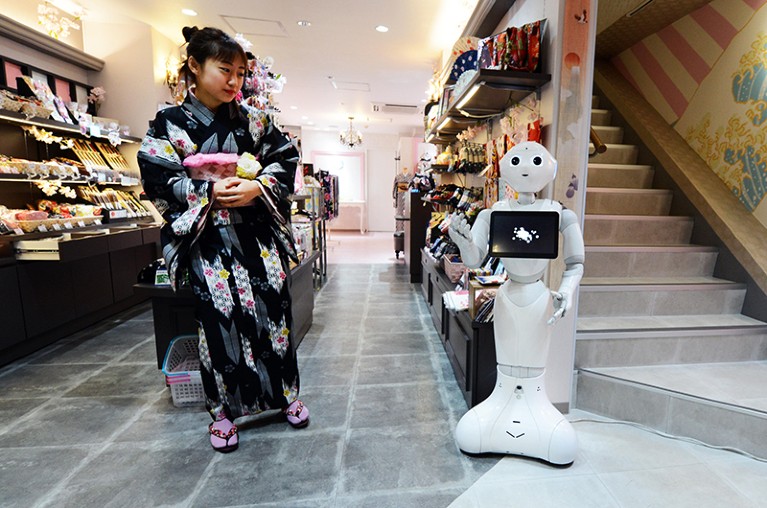
Japan’s abiding love of machines gave it an early and natural advantage in robotic technology and acceptance.Credit: Yoshio Tsunoda/AFLO/Alamy
For decades, Japan has been synonymous with developing cutting-edge robots. Yet the country’s reputation as a leader in the field might be outdated. Although Japanese roboticists do still produce “amazing papers” and “are very present” in the research community, says Manuela Veloso, head of artificial intelligence (AI) research at investment bank JPMorgan Chase, and a professor emerita of computer science at Carnegie Mellon University in Pittsburgh, Pennsylvania, an expectation that they would be the global leaders in robotics has not been fulfilled.
Data support this view. The Nature Index ranks Japan fifth in the world for its overall Share — a fractional count of author affiliations in index publications — but when Share in only AI and robotics research is considered, Japan falls to seventh. None of Japan’s research institutions make it into the top 30 for AI and robotics, based on Share from 2015 to 2021, and Japan is also increasingly being outperformed by its neighbours in east Asia. South Korea, for example, increased its Share in AI and robotics in the Nature Index by 1,138% between 2015 and 2021, whereas Japan’s increase was 397% over the same time frame.
Although much of this trend could reflect Japan’s sluggish performance in the rapidly growing field of AI, rather than pure robotics, Japanese robotics experts are well aware of these discouraging statistics. But they also think that opportunities still exist for Japan to climb back to the top for certain specialities. Doing so, however, will require deep understanding of what went wrong in the first place, and a focus on harnessing Japan’s unique cultural and scientific strengths to make up for those shortcomings.
One of the nation’s natural advantages in robotics is an abiding love of machines, Veloso says. Japan also has a long history of animism — the belief that objects, places and creatures possess a spiritual essence. “Many Japanese people think that everything has a soul — why not robots?” says Minoru Asada, an emeritus roboticist at Osaka University. Robots are frequently viewed with scepticism and even fear in the West, Asada continues, but in Japan they are often seen as “partners and family members”. This view is reinforced by robots featuring in decades of popular manga and anime — Japan’s world-famous style of cartoons and animation — including classic works such as Astro Boy, Doraemon and Phoenix. These have inspired many of Japan’s leading roboticists over the years. “Phoenix predicted a future symbiotic society with robots and was very, very influential for me,” Asada says.

Source: Nature Index
Early adopters
Japan began developing industrial robots in the 1960s. By the 1980s, numerous large companies were involved in the industry and Japan had come to be regarded as a “robot superpower”, says Yasuyoshi Yokokohji, a mechanical engineer at Kobe University. In 1983, a group of robotics researchers also established the country’s first robotics society to advocate for the creation of a new academic discipline for their speciality. This solidified Japan’s place as “a pioneer in robotics in both the industry domain and academia”, Yokokohji says.
Japan next set its sights on humanoid robots, most famously with Honda’s ASIMO, unveiled in 2000. Around the same time, Sony’s Aibo, a programmable robotic dog, could also be found in homes around the world. “Nobody else was producing any robots at that time, but Japan was making them,” Veloso says.
Fast forward to the 2010s, however, and Japan was falling behind. Boston Dynamics, a robotics company in Massachusetts, had pulled ahead in developing humanoid robots, and Universal Robots, a firm based in Odense, Denmark, had released industrial robots with a user-friendly programming interface and more flexible applications. “Compared to that, the programming interfaces made by Japanese robot companies were only for experts,” says Akihiko Yamaguchi, founder and director of FingerVision, a robotics start-up based in Tokyo. China, meanwhile, had started actively pursuing robotics and began producing and selling its own industrial models — many of which were based on Japanese designs — at a lower price point than those manufactured in Japan. “Basically, China is just making copies of Japanese technologies,” says Hiroshi Ishiguro, a roboticist at Osaka University. “But they have more people and their labour cost is much cheaper, so they can easily have mass production.”
What changed everything, however, was the rise of AI technologies such as deep learning and neural networks around 2012, Ishiguro says. AI research began requiring “very big computers and huge amounts of data”, he says, which in turn required investment. Japan lacks the mega-company equivalents to Google or Amazon that could provide support for working with big data, and the Japanese government could not provide the necessary funds for such research either.
Need for innovation
Most Japanese scientists continued to pursue pure robotics research, but internationally the application of advanced AI technologies had begun to merge with robotics. “AI and robotics are not separable,” Asada says. “Big changes happened, and we could not catch up.”
Against a backdrop of mounting external pressures, internal factors in Japan had also begun to hinder the country’s robotics research and development. Most of Japan’s university robotics laboratories belong to schools of mechanical engineering rather than computer science, Yamaguchi says, and universities typically do not offer the option of double degrees. This structural problem perpetuates knowledge gaps among Japan’s up-and-coming roboticists about machine learning, computer vision, statistics, data science, programming and more — all integral skills for working with AI, says Yamaguchi.
Leading Japanese institutions in AI and robotics
Only two institutions achieved a Nature Index Share above 50 from 2015 to 2021 in the fields of AI and robotics — the University of Tokyo and the government’s RIKEN research institute.
Rank |
Institution |
Sector |
Share 2015–21 |
Count 2015–21 |
Global rank |
|---|---|---|---|---|---|
1 |
The University of Tokyo |
Academic |
118.05 |
460 |
33 |
2 |
RIKEN |
Government |
63.89 |
240 |
68 |
3 |
Osaka University |
Academic |
44.35 |
256 |
110 |
4 |
Kyoto University |
Academic |
30.26 |
226 |
171 |
5 |
Tohoku University |
Academic |
22.86 |
131 |
227 |
6 |
Hokkaido University |
Academic |
22.30 |
72 |
239 |
7 |
National Institute of Advanced Industrial Science and Technology |
Government |
16.54 |
63 |
297 |
8 |
Nagoya University |
Academic |
14.84 |
189 |
322 |
9 |
National Institute for Materials Science |
Government |
14.56 |
49 |
330 |
10 |
University of Tsukuba |
Academic |
14.42 |
142 |
333 |
Language is also an issue. Not all robotics experts in Japan are proficient in English, Ishiguro says, making it difficult to keep up with a rapidly growing, international field. Unless Japanese research is translated, it also tends to stay in Japan. “It can be difficult because a lot of really good research in Japan is written in Japanese,” says Woodrow Hartzog, an expert in technology law at Boston University in Massachusetts who frequently works in Japan.
Compared with most other countries, Japan’s universities are also less internationalized, primarily thanks to the fact that almost all faculty meetings, documents and classes are in Japanese. “The number of foreign students has been increasing, but still, we treat them as foreigners,” Asada says. Japanese students, conversely, are less present at top universities abroad. “I’ve been at Carnegie Mellon for 30 years, and we’ve had a handful of Japanese PhD students,” Veloso says. “How many Chinese students have we had? Hundreds.”
Many robotics labs in Japan are also focused on “developing robots simply because they want to develop robots, without thinking about applications”, Yokokohji says, which can limit the scope of the research they produce. On the other hand, roboticists who are interested in creating practical innovations face obstacles, because Japan’s national universities usually have policies barring professors from becoming company chief executives.
Academics in general typically do not collaborate with researchers in industry, Asada says. Japanese institutions did not account for any of the Nature Index’s top 50 academic–corporate partnerships based on bilateral collaboration score between 2015 and 2021. This division is primarily the result of a top-down, conservative corporate culture that is averse to change, says Tetsuya Ogata, director of the Institute for AI and Robotics at Waseda University in Tokyo. “We need original innovation, but Japanese companies basically lack that.”
Cultural strengths
The same old-school model also applies to many universities. Young professors are usually not allowed to be principal investigators, and are expected to be deferential to superiors — a power dynamic that hinders progress at the expense of the entire field, Yamaguchi says. In 2018 and 2019, for example, Yamaguchi was working as an assistant professor at Tohoku University and was tasked with teaching a class on Fortran — an old computer language with little, if any, practical application for today’s students. “No AI and robotics researchers use such an old language,” he points out, yet there was nothing he could do about it. “Young professors do not have many rights, so it’s difficult to change such an old-fashioned situation.”

In Japan, robots are often seen as valuable family members.Credit: Boaz Rottem/Alamy
Some experts see Japan’s fall from the top of the robotics field as an opportunity for positive change. “Maybe we need to have the experience of being the loser, of feeling the risk,” Asada says. “Then we can say, ‘OK, we have to fight.’”
There are some signs that things are slowly evolving, such as the opening of a series of new private universities in various disciplines, including the International Professional University of Technology (IPUT) with campuses in Tokyo, Nagoya and Osaka, in 2020 and 2021. IPUT is part of a national initiative launched by the Ministry of Education, Culture, Sports, Science and Technology aimed at strengthening the connection between academia, industry and society. More than 40% of IPUT’s professors come from industry, and all students must complete 600 hours of internships to gain real-world experience. Asada, who was recruited in 2019 to be IPUT Osaka’s vice-president, hopes that this new educational approach will help to reinvigorate robotics in Japan.
Promisingly, the Japanese government also undertook “a significant upgrading” to privacy and data-protection laws in 2022, Hartzog says. This is a necessary step in preparing for a safe and sustainable development of robots and AI, and shows that “Japan seems to be following the lead of the European Union in making moves to try to create robust frameworks to accommodate new technologies”, Hartzog says.
Yokokohji emphasizes, however, that although this is a good start, the country is still missing “a more consistent and long-term strategy to promote robotics research”.
Such long-term support would enable Japanese robotics experts to play to their strengths within the broader international field, says Asada. Japan is still a leader in producing complex mechanical parts, for example, but most AI researchers around the world currently work in the digital realm. Japan could be key to bridging that gap between software and hardware, Ogata says, becoming a leader in making intelligent, humanoid robots and other types of interactive devices.
Japanese consumers would be likely to embrace such technologies and integrate them into their daily lives, and that national proof of concept could pave the way to international adoption, says Ishiguro. “The key point is how can we use our cultural background for developing a new world with robots?” he says. “I think this kind of challenge is good for the Japanese.”


 Is Japan’s research decline turning a corner?
Is Japan’s research decline turning a corner?
 How Japanese science is trying to reassert its research strength
How Japanese science is trying to reassert its research strength
 Japan’s leading international partnerships
Japan’s leading international partnerships
 Freeing up Japan’s PhD potential
Freeing up Japan’s PhD potential
 Japan’s rising research stars: Mariko Kimura
Japan’s rising research stars: Mariko Kimura
 Japan’s rising research stars: Yuuki Wada
Japan’s rising research stars: Yuuki Wada
 Japan’s rising research stars: Tatsuya Kubota
Japan’s rising research stars: Tatsuya Kubota
 Japan’s rising research stars: Yasuka Toda
Japan’s rising research stars: Yasuka Toda
 Japan’s rising research stars: Ken-ichi Otake
Japan’s rising research stars: Ken-ichi Otake
 Will Japan’s new ¥10-trillion university fund lift research performance?
Will Japan’s new ¥10-trillion university fund lift research performance?
 Shoring up Japan’s research performance
Shoring up Japan’s research performance
 How Japan’s disciplinary strengths are shifting focus
How Japan’s disciplinary strengths are shifting focus







